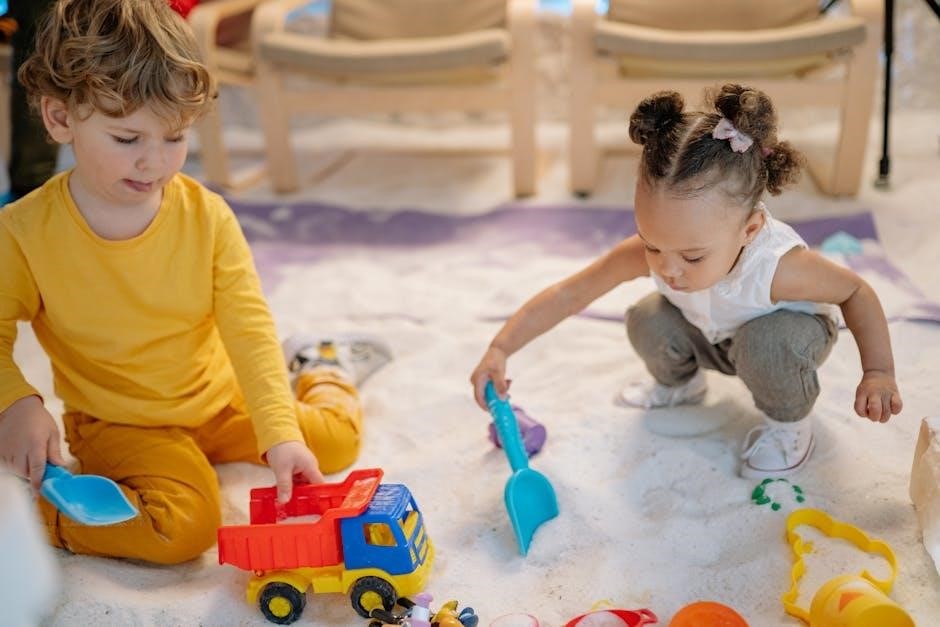Language development is crucial for 3-5 year olds, enhancing communication, literacy, and cognitive skills. Activities like storytelling, role-playing, and singing foster vocabulary growth and comprehension, laying the foundation for lifelong learning and social interaction.
Importance of Early Language Development
Early language development is vital for children aged 3-5, as it lays the foundation for communication, literacy, and cognitive growth. Research shows that language skills developed during these years significantly impact future academic performance and social interactions. Vocabulary expands rapidly, with children learning thousands of words annually. Strong language abilities enhance problem-solving and creativity, while also fostering emotional intelligence and confidence. Investing time in nurturing these skills supports lifelong learning and personal development, making it a critical focus during early childhood education.
Overview of Activities for 3-5 Year Olds
Activities for 3-5 year olds are designed to foster language development through engaging and age-appropriate methods. These include storytelling, role-playing, singing, and interactive games that promote vocabulary growth and comprehension. Simple, repetitive tasks like labeling objects and using flashcards also play a role. Group activities, such as shared storytelling and pretend play, encourage collaboration and communication. These methods create a fun, supportive environment that nurtures linguistic skills and prepares children for future academic and social success.
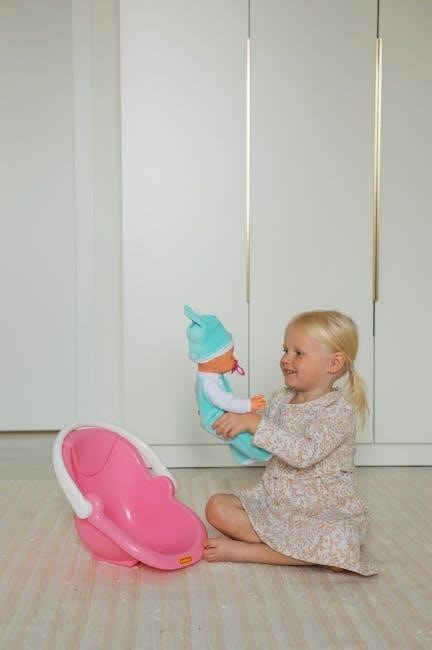
Storytelling and Reading Aloud
Storytelling and reading aloud engage young children, fostering language development through interactive dialogue, vocabulary exposure, and comprehension skills, while nurturing a love for stories and future literacy.
Interactive Reading Techniques
Interactive reading techniques involve engaging children actively during storytelling. Pointing to pictures, asking open-ended questions, and encouraging predictions foster vocabulary growth and comprehension. Role-playing characters or using props enhances understanding. Reading aloud with expression and pausing for discussion makes sessions dynamic. These methods stimulate curiosity, promote language skills, and create a joyful learning environment, helping children connect words with meanings and develop a strong foundation for future literacy and communication abilities. Consistency and creativity in these interactions are key to fostering a lifelong love for reading and learning.
Using Stories to Encourage Vocabulary and Comprehension
Stories are a powerful tool for expanding vocabulary and improving comprehension in young children. Reading diverse tales exposes them to new words, contexts, and sentence structures. Discussing story plots, characters, and themes encourages critical thinking and understanding. Using pictures to identify objects and emotions further enhances learning. Encouraging children to retell stories in their own words or act out scenes boosts language skills. This engaging approach helps build a strong foundation for literacy and fosters a deeper connection to language and storytelling, making learning enjoyable and effective for 3-5 year olds.

Role-Playing and Pretend Play
Role-playing and pretend play are essential for fostering creativity and language skills in 3-5 year olds. These activities encourage imaginative dialogue, problem-solving, and social interaction, helping children express thoughts and emotions effectively while developing their communication abilities through playful scenarios.
Using Props to Enhance Language Skills
Props like toys, puppets, and everyday objects can significantly enhance language development in 3-5 year olds. By incorporating these items into pretend play, children are encouraged to engage in meaningful conversations, describe actions, and use descriptive language. For instance, using a toy phone can prompt discussions about calling family members, while a play kitchen can lead to conversations about food and cooking. This hands-on approach makes learning interactive and enjoyable, fostering both vocabulary expansion and storytelling abilities. These tools help bridge imagination and reality, providing context for language practice and creative expression.
Encouraging Creative Dialogue in Play
Encouraging creative dialogue in play is essential for fostering language skills in 3-5 year olds. By allowing children to take on roles and imagine scenarios, they naturally practice articulating thoughts and emotions. Adults can support this by asking open-ended questions, such as “What do you think the doll is feeling?” or “What should the knight do next?” This approach not only stimulates vocabulary but also helps children develop narrative skills and understand different perspectives. Creative dialogue in play builds confidence and lays the groundwork for effective communication in all areas of life. Consistency and engagement are key to maximizing these benefits.
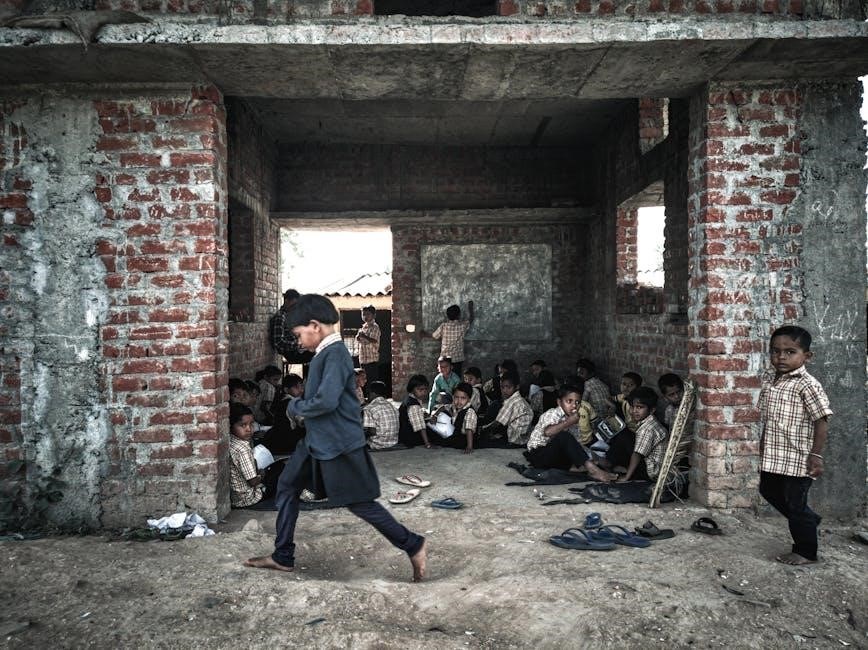
Singing Songs and Reciting Nursery Rhymes
Singing songs and reciting nursery rhymes are powerful tools for language development, enhancing phonological awareness, rhythm, and memory. These activities introduce new vocabulary and foster a love for language through playful engagement.
How Music Enhances Language Development
Music significantly enhances language development in 3-5 year olds by improving phonological awareness, rhythm, and memory. Singing songs exposes children to rhyme, meter, and repetition, which aid in recognizing word patterns and sentence structures. Melodies help children develop intonation and stress, making language more understandable. Action songs further link gestures with words, promoting comprehension and vocabulary production. These musical activities create a playful and engaging environment, fostering a natural and enjoyable path to language mastery and expression.
Engaging Children with Action Songs and Rhymes
Action songs and rhymes are powerful tools for language development, combining movement with music to captivate young learners. These activities enhance memory, rhythm, and coordination while introducing new vocabulary. Repetitive phrases in rhymes help children recognize patterns and predict outcomes, fostering phonological awareness. Singing with gestures links physical movement to words, making language more tangible and engaging. This playful approach not only boosts vocabulary but also encourages participation, turning learning into a fun, interactive experience that supports overall linguistic growth and creativity in 3-5 year olds.
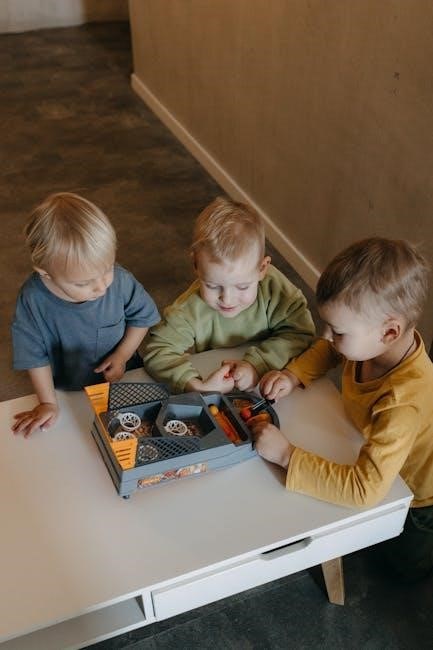
Interactive Games for Language Development
Interactive games like action and word games enhance language skills through playful engagement, fostering vocabulary, listening, and communication in a fun and educational manner for young children.
Word Games and Vocabulary Building Activities
Engage children with word games like matching, scavenger hunts, and interactive exercises to expand their vocabulary. Use flashcards, rhyming games, and sorting activities to introduce new words. Incorporate labeling objects in their environment to reinforce vocabulary. Encourage repetition and context-based learning to enhance understanding; These activities not only build vocabulary but also improve communication skills, making language development a fun and interactive process for 3-5 year olds.
Action Games That Promote Language Skills
Action games like “Simon Says” and “Red Light, Green Light” encourage children to follow directions, enhancing listening and comprehension skills. Games such as “Follow the Leader” and “Charades” promote verbal and non-verbal communication. Activities like “What’s Missing?” and “Treasure Hunts” involve giving clues, fostering problem-solving and language expression. These dynamic games make learning engaging while helping children develop essential vocabulary and sentence structure in a playful, interactive manner.
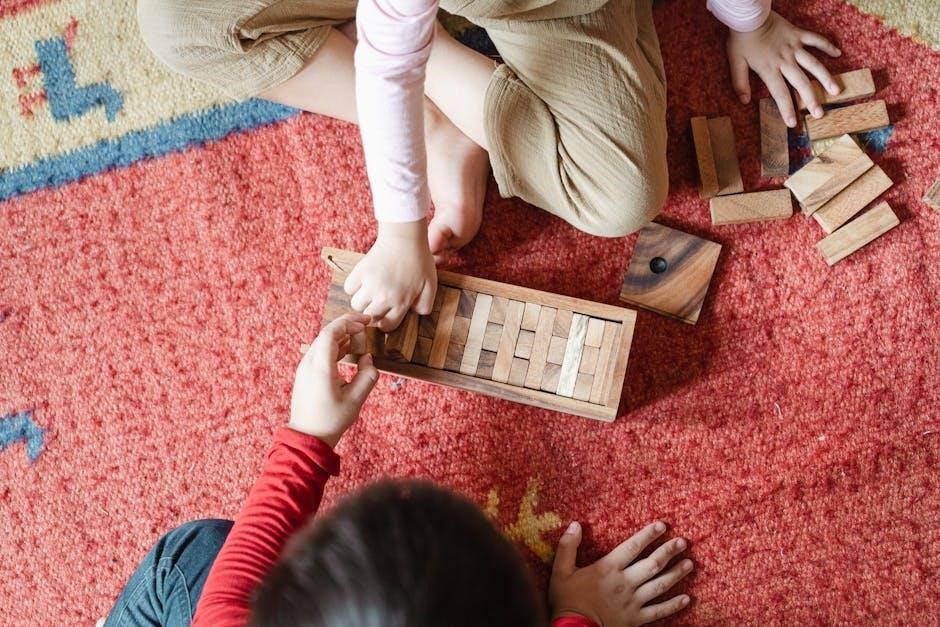
Vocabulary Development Activities
Engage children with flashcards, labeling objects, and reading to expand their vocabulary. Interactive play and discussions help children understand and use new words effectively in sentences daily.
Teaching New Words Through Play
Play is an effective way to introduce new vocabulary to 3-5 year olds. Use role-playing and props like pretend food or toys to create engaging scenarios. For example, act out a picnic and use words like “blanket,” “basket,” or “pepper.” Repeat words in context to reinforce memory. Encourage children to use the words themselves by asking open-ended questions or prompting them to describe their actions. This interactive approach makes learning fun and helps build a strong foundation for language skills, fostering creativity and confidence in communication.
Using Flashcards and Labeling Objects
Flashcards and labeling objects are simple yet effective tools for vocabulary building in 3-5 year olds. Use clear images or objects with corresponding words, repeating them multiple times for retention. Label items in the child’s environment, such as toys or furniture, to create a immersive learning experience. Encourage children to repeat the words and use them in short sentences. This method reinforces word-object association and helps expand vocabulary in a fun, interactive way, making learning engaging and accessible for young learners.
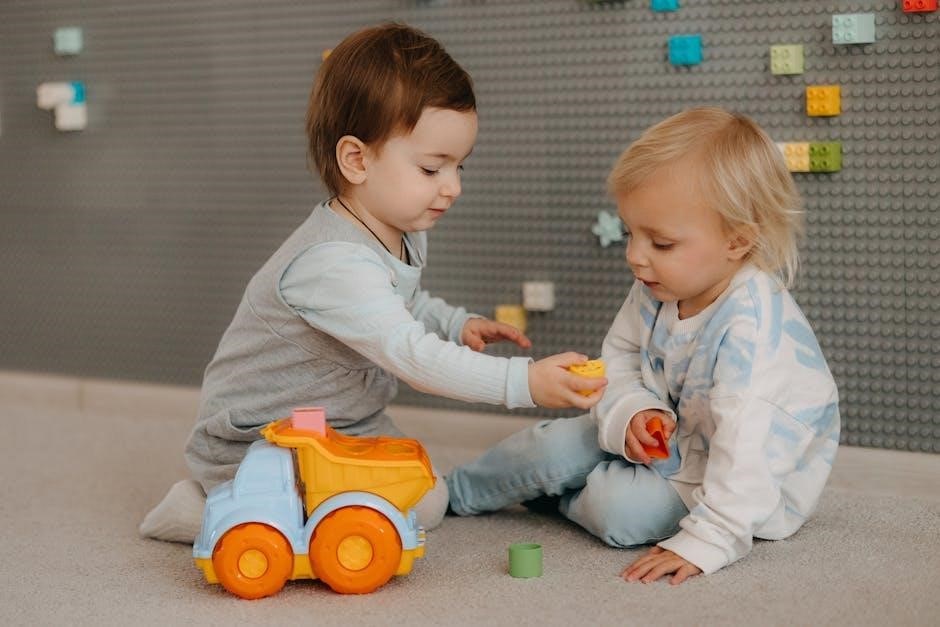
Encouraging Communication Through Conversations
Encouraging communication through conversations fosters language development in 3-5 year olds. Engage in daily talks, share stories, and create opportunities for them to express thoughts, enhancing confidence and vocabulary.
Asking Open-Ended Questions
Asking open-ended questions encourages children to think deeply and articulate their thoughts. These questions, which cannot be answered with a simple “yes” or “no,” promote critical thinking and creativity. For example, asking “What do you think will happen next in the story?” or “How do you feel about this situation?” helps children express their ideas and feelings. This activity strengthens language skills, enhances problem-solving abilities, and fosters a deeper understanding of the world around them. It also builds confidence in communication and nurtures a love for learning.
Listening and Responding to the Child
Listening and responding to the child is a powerful way to support language development. By actively engaging with their words, parents and educators validate their thoughts and encourage further communication. This interaction boosts the child’s confidence and enhances their ability to express ideas clearly. Strategies include reflecting the child’s statements, asking follow-up questions, and expanding on their vocabulary. Such responsive communication fosters a supportive environment where children feel heard and motivated to refine their language skills through meaningful conversations.
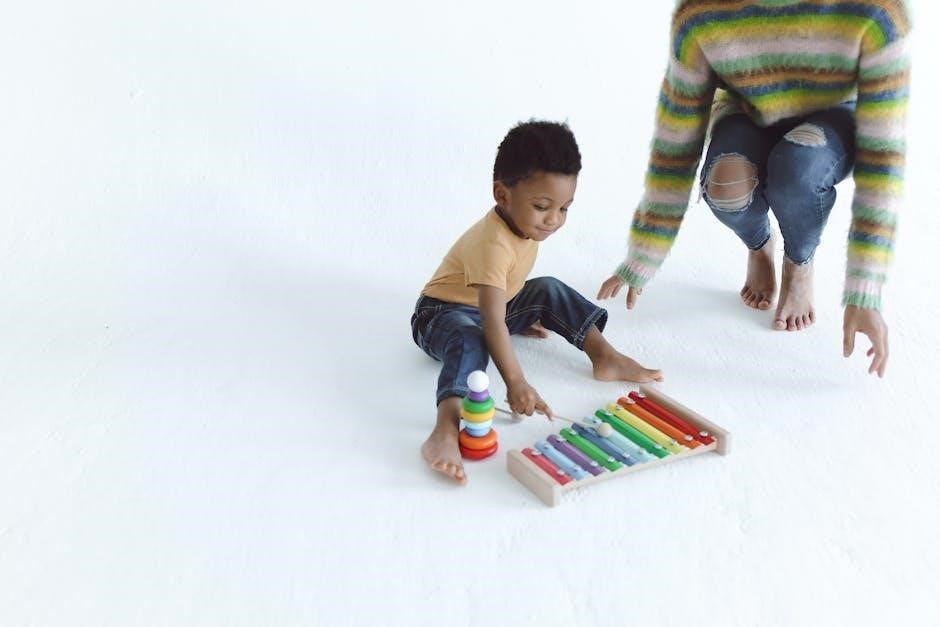
Group Activities for Language Development
Group activities, like storytelling and role-playing, enhance language skills through collaboration and communication, fostering social interaction and shared learning experiences among 3-5 year olds.
Group Storytelling and Sharing Experiences
Group storytelling and sharing experiences are powerful tools for language development. Children participate actively, taking turns to contribute ideas, fostering collaboration and creativity. This activity enhances communication skills as they describe events or create narratives together. It also promotes comprehension and problem-solving, encouraging children to listen and build on others’ ideas. Sharing experiences in a group setting helps develop empathy and social skills, making learning engaging and fun for 3-5 year olds.
Role-Playing in Small Groups
Role-playing in small groups encourages social interaction and language development among 3-5 year olds. Children engage in pretend scenarios, fostering creativity and communication. Using props and imaginative play, they practice dialogue and problem-solving, enhancing their vocabulary and comprehension. These activities allow children to explore different roles and perspectives, promoting empathy and teamwork. Small group role-playing provides a supportive environment for young learners to build confidence in expressing their thoughts and ideas.

Using Technology for Language Development
Technology enhances language learning through interactive apps and digital tools, offering engaging activities that promote vocabulary and comprehension in a fun and accessible way for young children.
Educational Apps for Language Learning
Educational apps offer interactive and engaging tools for young children to learn new words, phrases, and language structures. Many apps feature games, puzzles, and activities designed to make learning fun. They often include animations, sounds, and repetition to capture children’s attention and reinforce language skills. Some apps allow for personalized learning paths, adapting to a child’s progress and interests. Additionally, speech-based activities help improve pronunciation and comprehension. These tools are valuable supplements to traditional methods, providing accessible and enjoyable language practice for 3-5 year olds.
Digital Tools for Interactive Storytelling
Digital tools like interactive e-books and storytelling apps provide engaging ways for children to explore language. These tools often feature animations, voice narration, and touch-based interactions that bring stories to life. Children can tap on words to hear pronunciation, interact with characters, or even create their own stories. Such tools enhance vocabulary, comprehension, and creativity while making learning fun. They also allow children to practice language skills at their own pace, fostering independence and confidence in their abilities. These tools are valuable for modern, tech-savvy learners.

Assessing Language Development Progress
Monitoring progress through observation, checklists, and developmental milestones helps track improvements, guiding tailored activities to support individual growth and communication skills effectively in young learners.
Identifying Milestones in Language Development
At 3-5 years, children typically expand vocabulary, form complex sentences, and understand stories. They begin using pronouns correctly and engage in simple conversations. By age 4, they can describe events and by 5, articulate thoughts clearly. Tracking these milestones helps ensure proper development, allowing early intervention if delays occur. Consistent interaction and engaging activities support reaching these language goals, fostering a strong foundation for future communication skills and academic success.
Using Assessment Tools to Track Progress
Standardized tools and checklists help monitor language development in children. Regular assessments track progress, ensuring timely interventions. These tools align with developmental milestones, providing insights into communication skills. By documenting improvements, caregivers can tailor activities to meet individual needs, fostering growth and addressing delays early. Consistent use of these tools supports informed decision-making, helping children build strong language foundations for future success.
Consistent engagement in language activities fosters strong communication skills, preparing children for future academic and social success. Making learning fun ensures lasting development and a lifelong love for language.
Consistency in Language Development Activities
Consistency is key to fostering strong language skills in 3-5 year olds. Regular engagement in activities like storytelling, role-playing, and singing ensures steady progress. Establishing daily routines for these practices helps children develop a predictable learning environment. Over time, this consistency strengthens their ability to communicate effectively and build a robust vocabulary. By maintaining a structured yet flexible approach, caregivers can create a supportive atmosphere that encourages language growth and confidence.
Making Learning Fun and Engaging
Making learning fun is essential for 3-5 year olds. Incorporate playful activities like word games, puzzles, and interactive storytelling. Use expressive voices, gestures, and facial expressions during reading to captivate their interest. Positive reinforcement and encouragement boost confidence. Create a welcoming environment with colorful visuals and engaging tools. Allow children to lead activities, fostering curiosity and excitement. Combining learning with play ensures they develop language skills while having fun, making the process enjoyable and effective.
